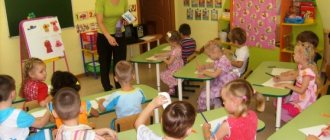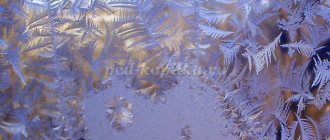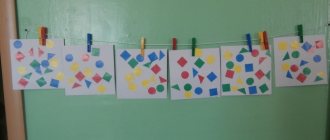Lesson notes for the middle group. History of the book
Summary of educational activities in the middle group “How the book appeared”
Author: Svetlana Aleksandrovna Kolesnikova, teacher. Place of work: MKOU "Berezovskaya Secondary School named after Hero of the Soviet Union G. A. Rubtsov" structural unit kindergarten Purpose: The notes are intended for children of the middle group. Designed to broaden children's horizons about subjects familiar from childhood. Goal: To expand children's knowledge about the book. Objectives: To introduce children to the history of the creation of books and the material from which books were made. To form in children the idea of caring for books.
Progress of the lesson
Educator: Hello guys! How cheerful and joyful you are today. Let's share our joy with the whole world. (Children stand in a circle and hold hands)
All the children gathered in a circle.
You are my friend and I am your friend. Let's hold hands tightly and smile at each other. Well done boys. Today we will have a very interesting lesson. Try to guess what we will talk about. I will tell you a riddle, and you guess it, this will be the topic of our lesson. Glued and stitched, closed without doors. Whoever opens it knows a lot. Children: Book Educator: That's right guys, this is a book. (The teacher's assistant enters and brings in the parcel) Postman: There is a parcel for you, sign for it. Educator: How interesting, who is the package from? (Reads)
It says: “Children in kindergarten.”
So to us, but who is it from? (Reads)
“From the country of CHITLAND from Queen Daisy.”
Let's quickly print it out and find out what's inside. (Prints it out and takes out the letter)
.
“Dear guys, I am Queen Daisy, I invite you to my place. I am sending you a gift, but it is not simple, but with a secret. I need to solve a few of my riddles. If you guess all of them, you will find out what kind of gift this is and where I am inviting you.” Well, guys, let's complete the tasks of Queen Marigold? Children: Yes Educator: Well then the first riddle: There are fields, there are leaves, The land of miracles will show us! It’s not boring with her, it’s interesting, We will learn a lot. Children : Book Educator: Here's your second riddle: There is a large and important multi-storey house against the wall. We're on the ground floor. We've already read all the tenants. Children: Bookcase Educator: Well done, then we listen to the following riddle: From the outside you look - the house is like a house, But there are no ordinary tenants in it. There are interesting books there, standing in close rows. On the long shelves along the wall, there are tales of old. And Chernomor, And Tsar Guidon, And good grandfather Mazai. What is the name of this house? Try and guess? Children: Library Educator: Well done guys. You have solved the riddles of Queen Daisy. What do you think she sent us as a gift? Children: Book (The teacher takes a book from the parcel) Teacher: Yes, that's right. Where did she get it? Children: In the bookcase. Educator: Okay. Where is the bookcase? Children: In the library. Educator: Great, then Queen Margarita invites us to her library. Are we leaving? Children: Yes (Excursion to the school library. Our kindergarten is located at the school, the library is on the second floor.) Librarian: Hello guys, I’m very glad to see you. I invited you to my place because I want to introduce you to the book. Today you will learn the history of the book. When did it appear and what happened before it? Librarian: Guys, what do you think a person needs a book for? Children: (Children's answers) Librarian: Yes, a book is needed to write something necessary and interesting in it. And so that all people can read it. But imagine, the book didn’t always look like it does now. In ancient times, people did not know how to make paper and did not even know how to write letters. How do you think people began to transmit information? Children: (Children's answers) Librarian: People drew the first information and, one might say, the first book on stone. Sitting in caves on long evenings, people began to paint scenes from life on the walls. These were mainly hunting scenes.
Then people learned to write with signs. And they began to use for this what nature gave them. Bones and skins of animals in the north,
birch bark - birch bark in the middle zone,
palm leaves in warm regions.
Later they learned to write on clay tablets. In the ancient world they wrote on wax tablets. They wrote on such tablets with a special wedge-shaped stick, and such writing was called “cuneiform.”
In ancient Egypt they figured out how to use the papyrus plant.
And in the city of Pergamum they began to tan the skins of sheep, goats and calves. This paper was called parchment. It took a whole flock of sheep to make one book. Therefore, such books were very expensive. But these were already real books with sheets and binding.
The first real paper was invented in China. At first it was made from silk, and then they learned to make it from ground wood - cellulose.
The first books were handwritten. They were written by specially trained people - scribes.
Later the printing press was invented. Johannes Gutenberg did it. In our country, the first books were published by Ivan Fedorov.
Educator: Well, guys, we learned about how books appeared. It's time for us to go home. (Returning from the school library). Educator: Well, here we are at home. Tell me, did you like our trip? What new have you learned? Children: (Children's answers) Educator: Guys, let's make our own book. Children: Come on Teacher: For this we need sheets of paper, scissors and a stapler. The paper needs to be folded in half, then in half again.
Cut the top folds.
Place the sheets inside each other.
And fasten with a stapler.
Well, our book is ready. All that remains is to write some kind of story in it or draw pictures. Reflection: Guys, where did we go today? What new have we learned? What did you like most?
We recommend watching:
Integrated music lesson in the middle group on the topic Spring Summary of a lesson in kindergarten on cognitive development with children of the middle group “The Journey of the Foxes” Summary of a lesson on cognitive development in the middle group “In Search of Treasures” Summary of GCD on plasticineography in the middle group on the topic: Healthy lifestyle
Similar articles:
Summary of a lesson in kindergarten in the middle group “What I love”
Math lesson “Rectangle” in the middle group of kindergarten
Mathematics lesson “Ordinal counting” in the middle group
First poetry
It is believed that Russian poetry for children traces its history back to the beginning of the 17th century, when in the Primer, in addition to church texts, the author’s poem by Savvaty, the reference director of the Moscow Printing House, was first published. The poems were edifying: the poet advised young readers to abandon “all philosophizing” and work hard and reminded them of the harm of “laziness and negligence to everyone in learning.”
Savvaty Solovetsky. Image: monasterium.ru
Simeon of Polotsk. Image: posmotrim.by
“The Big Primer” by Karion Istomin (fragment). Image: mynnm.ru
Another poet, the monk and theologian Simeon of Polotsk, is known as the creator of the Primer of the Slovenian Language. Polotsky was also the author of poetic books for the Tsar’s children; in particular, he created a collection of moral and instructive stories, “The Many-Colored Wind City.”
Another court poet, Karion Istomin, wrote a book about raising children, which he called “Domostroy” - by analogy with the famous work of the same name by the priest Sylvester. Istomin noted that children more easily learn the rules of good manners and Christian morality from short poems. He also published The Big Primer, where illustrations first appeared. This manual was reminiscent of modern ones: each page was devoted to one letter, and the engravings depicted objects and animals whose names began with the letter.
First stories
For the ancient Russian chroniclers, who were the authors of a kind of prose literature, the concept of “age psychology” did not exist, and therefore there was no prose designed for children in Rus' until the middle of the 17th century.
Philologist Irina Arzamastseva says that at that time the process of transition from educational literature to works of artistic and scientific-educational orientation began: “The educational book gave the child ready-made information that only had to be memorized. Such a book was aimed at one-sided thinking of the reader, accustoming him to someone else's monologue. In parallel, literature is developing, building a dialogue with the child, reflecting his childish “I”, answering his “why”.
In the middle of the 17th century, they began to rework, shorten and simplify knightly and Russian military stories: “The Tale of the Massacre of Mamayev”, “The Tale of Eruslan Lazarevich”, “The Tale of the Siege of the Don Cossacks”, “The Tale of Peter and Fevronia”. The genre of the story also began to take shape: one of the early stories tells the story of a criminal son who, on the way to execution, bit off his mother’s ear. He explained this by saying that his mother was the culprit of his death, since she did not punish him for the first theft.



